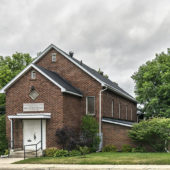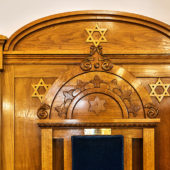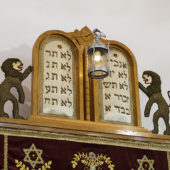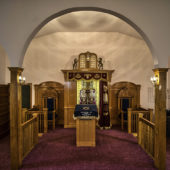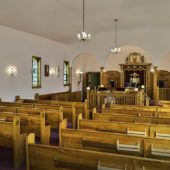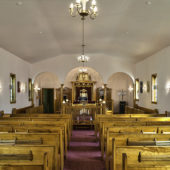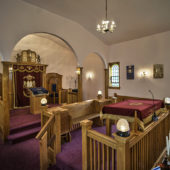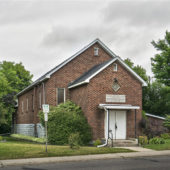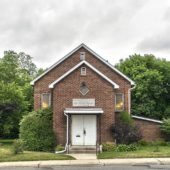A cohesive congregation serving nearby Ontario and Michigan’s Upper Peninsula.
The following article about Congregation Beth Jacob was written by Bryna Coppel-Park and Carol M. Line in 1996.
Taking Our Place
The Changing Role of Jewish Women in a Small Northern Ontario Community
By Bryna Coppel-Park and Carol M. Line, 1996
There has been a Jewish community in Sault Ste. Marie, Ontario since the end of the last century. In the years preceding the 1890s, Jewish men, almost always from Eastern Europe and Russia, came to the remote areas north of the Sault. Here there was a demand for their peddled goods and they found opportunities as itinerant merchants or fur traders. By the 1890-1900s almost all Jewish families were business owners. Most of the women worked alongside their husbands, some even had stores of their own. In one family, the husband had a men’s wear store on the south side of the street and his wife had a ladies’ wear store on the north side. The majority of the women of this generation came from Eastern Europe but a few grew up in southern Ontario communities like Cornwall, Toronto, Hamilton, and Ottawa. All had in common the will to adapt and practice their Judaism the best way they could in the remote diaspora in which they found themselves.
Still today Sault Ste. Marie is a relatively small and isolated community. It has a population of 80,000, approximately one hundred of whom are Jews. It is a three and a half hour drive, in good weather, to Sudbury, the closest Jewish community in Ontario and a two hour drive to the Jewish community in Petoskey, Michigan. The Jews of Sault Ste. Marie are, of necessity, an independent group. Kosher meat must be ordered from a larger city. Every year we hold our breath to see where the Pesach order will need to be purchased. A mohel must be flown in from Toronto for circumcision duties. The congregation has no rabbi thus uses lay leadership for most services. A rabbi is imported for weddings, funerals, and the High Holy Days.
A majority of the women who settled in Sault Ste. Marie in the early days of the congregation followed traditional female roles modeled for them in Europe by their families and friends. They were homemakers, wives, mothers, and daughters. They saw to it that theirs was a Jewish home and that their children knew they were Jewish. In spite of the fact that observing kashrut was very difficult most kept a kosher home. Many Jewish women of that time spoke Yiddish and were able to read prayer books and Yiddish newspapers. This knowledge came with them from their home countries even though they had no formal Jewish education.
Women of the period before and immediately after the Second World War in Sault Ste. Marie were quite content with their roles. They took pride in their Jewishness and in their Jewish home. They were engaged in charitable projects within both the Jewish and secular communities. They assisted, as previously noted, with the family business. Synagogue ritual and observances were left to the men. There were no widespread feelings of discontent or disillusionment regarding the role of the Jewish woman during this period in the community’s history. Women had adopted a way of life which was, in large measure, a continuation of their gender role from the countries of Eastern Europe. Since they were relatively isolated, they did not feel the widespread press for changes in Jewish women’s roles which were engendered by the Second World War.
Although Jewish education was available in the community from teachers everyone called “rabbi” even though they were not ordained, this education was only offered to boys. Most girls who grew up in Sault Ste. Marie during that time had no formal Jewish education. In addition, since life in the Sault was conducted in English, they did not have the benefit of using Yiddish in their daily lives as – their mothers had.
In the 1950s, a new generation of women was born and raised in Sault Ste. Marie. The congregation encouraged them to retain their Jewish identity by allowing girls to obtain a Jewish education along with their male counterparts. However, according to one student of that time, depending on the teacher, the boys were often taught Hebrew while the girls were sent off to the corner to play. So, the quality of the education offered to girls was often suspect.
Women were still, however, not allowed to participate in services or in the ritual of bat mitzvah. Although this generation of women grew up in Jewish homes and had the opportunity to obtain a formal Jewish education, of sorts, many intermarried and stopped participating in Jewish life. A number left the community and carried on their Jewish lives as members of larger, urban synagogues where there was greater opportunity for equality.
In the ’60s and ’70s a new breed of Jewish woman settled in Sault Ste. Marie. Many were professionals pursuing careers on a full time basis. Most had the benefit of a Jewish education. Some were converts and were actively engaged in the practice of Judaism. They came primarily as members of families and began raising a new generation of children in the community. Some of these women, in the absence of a functioning Religious School at the time, began to educate themselves about Jewish education and became volunteer teachers. This was the first time that women actually took the role of instructors in this community. Now, formal Jewish education was not only equally available to all children in the community, regardless of gender, it was being taught by women. The question of what was to happen when the girls reached bat mitzvah age was understood. They would be called to the Torah as were their male peers. From this time forward no one seriously considered that girls would be excluded from this ritual.
The first bat mitzvah at Congregation Beth Jacob took place in 1988. It was celebrated and well attended by the entire congregation. The celebration of this bat mitzvah was a normal evolutionary process, which everyone expected and approved. It was never discussed; there was never any disagreement; the ritual occurred with great joy within the community.
However, problems began to emerge after the first bat mitzvah for two reasons. First, the bat mitzvah girl had to face the fact that, once her bat mitzvah was over, she still had no place in the synagogue services of the Sault community. These rituals were still closed to women. She sat in the synagogue, fully prepared to be an active, participating member and was denied the right to do so.
During this same period, a woman moved to the community who was a feminist and outspoken about her feelings. She made her displeasure with the current non-egalitarian practices of the Jewish community well known through both vocal and written communications. Since this family was new to the community, and because the woman began her residence in Sault Ste. Marie with a strident challenge to the existing power structure, her approach was the subject of much resentment. Two camps emerged with impassioned feelings on both sides.
During this same time period, our much beloved and respected congregation president of 25 years passed away. The new executive board was given the responsibility of rewriting the constitution. In the process, they began to realize that there were many women and some men in the congregation who, though less outspoken than our new member, supported the issue of egalitarianism for women in the synagogue. They connected this with the fact that our female religious school students who had become bat mitzvot still had no place in the services. At this time, the executive codified, in the new Bylaws, the egalitarian place of women in the services at Congregation Beth Jacob.
Reaching this decision was difficult because the community was very sensitive to the individual feelings ofeach of its members. We were one Jewish community, serving all area Jews, and we made it a priority to be conciliatory and understanding to those who had difficulty with the changes which were being proposed. We managed to make these changes without long term anger and dissension by encouraging continuous dialogue with dissenting members and minimizing adversarial interactions.
Congregation Beth Jacob recently celebrated the fiftieth anniversary of our present synagogue building. A great many men and women attended a very emotional weekend, returning after years of absence from their congregation, The lay leaders worried about the Friday night and Saturday morning services. How would past members with their own brand of orthodoxy respond to our evolving egalitarian participatory service? Most importantly, who should read from the Torah? We finally told ourselves that, ” This is how we do things now in Sault Ste. Marie.” On that Shabbat morning, our hundred person sanctuary was full. One of the Torah readings was done by one of our own students who had recently become a bat mitzvah. Women were called for honours as well as men. Some of these women had never stood before the open Torah, or even on the bimah before. The granddaughter of a former rabbi of the congregation read the Haftorah. Faces throughout the congregation shone with a sense of belonging. It was a tribute to the community when, at the dinner following Shabbat, one of our members who had been most resistant to the changes in women’s status, said to one of the authors, “I want you to be the first to know that I was wrong!”
At this stage in our community’s life we still allow for differences in feelings about the role of women in the synagogue. Many women don’t feel comfortable participating in services, either because of a lack of education, personal conviction, or both. We have developed a “code which tells the leaders of the service whether individual women wish to participate. If a woman wears a kippah (skull cap) and a tallit (prayer shawl) as the men in the congregation do, it is assumed that she is willing and is prepared to participate. Not all women feel comfortable with this “code” but it has allowed any woman who wishes to participate to take her place on the bimah.
Many women in the congregation who might wish to participate in services still cannot do so, because we lack continuing adult education resources. Many have never had the opportunity for formal education, or have had education which did not prepare them for participation. This is an issue which still needs to be addressed.
In addition, we are aware that our present Siddurim (prayer books) and Chumash5 translations are reflective of the gender exclusion of women which had been practiced over the past 50 years. A new look at these resources and others is in order at this time.
If a small Jewish community is to survive today, it must meet the needs of all its members. Women will need to be vocal and informed about the roles which they wish to undertake but also sensitive to the needs of others in the community who may come from different perspectives. Without this dual vision, change will be fraught with dissension and disruption and Jewish communities can be destroyed in the process.
In our sometimes slow, but generally inclusive and accommodating way, we believe that we have begun a twofold process, First, we strived to maintain the viability and vibrancy of our small Jewish community by resolving our differences with a minimum of confrontation and adversarial interactions. Second, and perhaps ultimately more important, we are raising a generation of Jewish women with a strong Jewish identity and the confidence that they, too, can take their places in whatever Jewish communities they choose to live in the future.
Bryna Coppel-Park is the coordinator of the Sexual Assaults Care Center in Sault Ste. Mark, Ontario. She grew up in Cambridge (Galt), Ontario where the once small but vibrant Jewish community no longer exists. Bryna has lived with her family in Sault Ste. Mary for the past nine year. She is currently a Board member of Congregation Beth Jacob and was the Chairperson of the congregation’s recent fiftieth anniversary celebration. (Passed away January, 2006)
Carol M. Line is a professional social worker and physical therapist who pew up in Detroit and moved to the Upper Peninsula of Michigan in 1974. She is Religious School Principal and a current Board member of Congregation Beth Jacob.(Passed away April, 2007)

